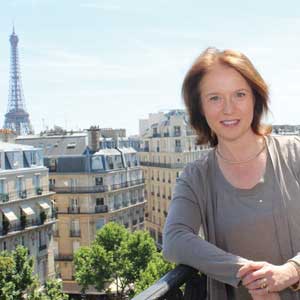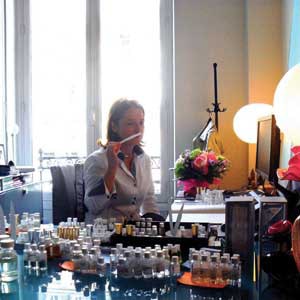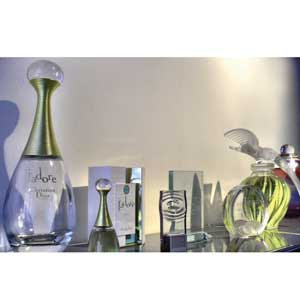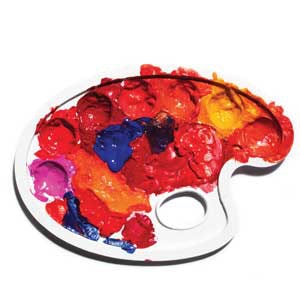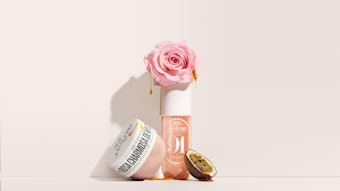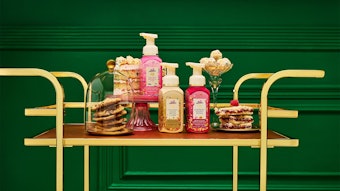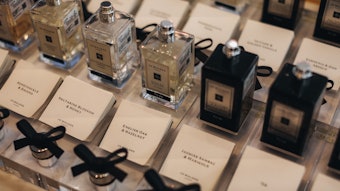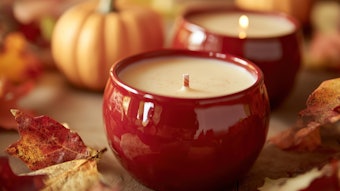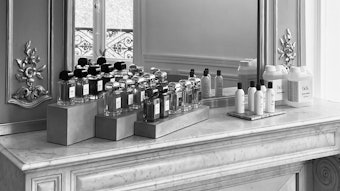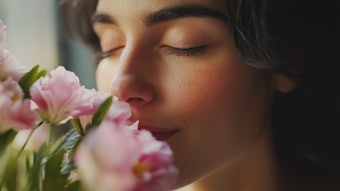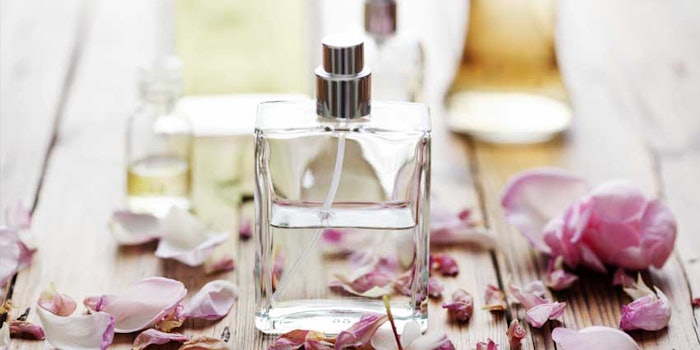
Many artists only became truly famous and appreciated after their death. In perfumery, we are lucky to have a few living legends whose work has achieved success and accolades in their time. Calice Becker is one of them.
She has created one of the most inspiring accords in modern perfumery (J’Adore Dior), most of the fragrances for By Kilian Collection, the trendsetting Tommy Girl and countless more – showing range and adaptability while leaving a clear signature of her own style.
Yet when you meet her, you discover an attitude of down-to-earth pragmatism coupled with a passion for beauty; a person very eager to share, and not a hint of pretentiousness or the airs and graces one might expect from a legitimate superstar of the fragrance world. There is the quiet confidence that comes from having earned one’s place in a profession; no interest in fame.
In fact, when we sit down at her desk on Avenue Kléber at Givaudan in Paris, we first end up chattering away about perfume appreciation like two enthusiasts who’d got together over a cup of tea. It is clear Calice thinks very deeply about her work – after all, perfumery is very cerebral – but she retains a childlike delight in her craft which shines through everything she does.
Bottled Flora
Calice Becker – full name, Calice Asancheyev-Becker – was born in France to Russian parents. Her grandparents were Russian émigrés to France and what was supposed to be a short escape from the Revolution turned to permanent settlement. Calice’s childhood was heavily influenced by her grandparents’ Russian customs, yet she was also immersed in French surroundings and traditions. It was her mother who encouraged her to pursue perfumery and to see things like an artist. As an artist and a sculptor, she recognized something in her daughter when Calice innocently wondered how the scent of flowers made it inside a perfume bottle.
Today, Calice is the vice president of perfumery at the world’s largest fragrance house, Givaudan, and splits her time between Paris and New York. She not only develops new fragrances for Givaudan’s clients but also participates in mentoring the next generation of perfumers there.
Creating a Signature Style
Whether perfumery is art, science, craft or a mix of all the three is a perpetual topic among perfume critics and enthusiasts. For Luca Turin, Becker’s creations are “a perfect example of radiant light” – something he told me in conversation about his work as a perfume critic. It is a good summary of Calice’s signature style, which could also be described as polished.
“I think everybody has a signature style. Absolutely. Because first of all, we have more or less 1,400 ingredients in the labs here – but we each have a palette of between 100 and 300 maximum as perfumers. So already here you have a little point of signature, like using certain colors in an artist’s palette, or a musician selecting which instruments to use; size of the orchestra. After that, the length of the formulation counts, too,” explains Calice.
Then it comes down to how to use those materials and what kind of perfumer’s brush stroke one adopts: “You can be like Johannes Vermeer where every brush stroke is tiny and you get a polished feeling from one color to the other or you can be like Georges Braque who placed his colors in big blocks,” says Calice.
“You can put a lot of work into polishing every piece of an accord, so I think that what Luca calls radiant – I think what I usually do is very sleek. You have two things, you have a level of familiarity and structure, enough so that you don’t reject anything that smells good but you also add abstractions to encourage people to keep going and smelling and smelling, so like a book, they want to keep discovering. It keeps the fragrance talking to you,” she explains.
“When I work, I do things in little pieces; little accords that I refine and polish – and afterward I put in another little piece that I’ve polished like that and tune them together. And another one and another – that means the composition is not made with big brushstrokes, it’s almost like airbrushing; very smooth movement from one accord to the other.”
The Art of Perfumery
“I think us perfumers are handicapped in that we don’t have our own vocabulary. What we do is pretty new. It is not something that was put together into a method more than 150 years ago. So when you compare architecture, music, painting, and so on—when these were established as methods you could teach in school—it was much earlier than with perfumery,” says Calice.
“Kids don’t learn anything about perfumery in school. I am sure we’ve all had some lessons in art and music—you were taught how to mix colors—but were you taught how to mix benzyl acetate and indole to give an impression of jasmine? No,” she says and smiles.
Calice identifies two main problems with perfumery: the relative newness of its methodology and its lack of distinct vocabulary; the need to borrow from other disciplines.
“On the other hand, it can be a positive, too – we can talk about the different arts and disciplines: [about] textures, taste, sight, sounds – so we are really using them all; all the senses,” she adds.
“I’ve had a client say to me ‘I want the scent to be a cathedral’ and I can imagine something high with a light coming in from the ceiling and on different levels through the stained glass. You can imagine it as an experience.”
For Calice, there is no question – perfumery is a form of art.
“Since music is part of culture and recognized as art, it is something that governments sponsor in academies – and that gives space for the artists to work for free, in a way. So they can experiment and research; they can create atonal music if they like. Even if this type of music isn’t very popular, there is space for experimentation.”
One can draw the comparison with some of the independent niche brands and experimental amateur perfumers out there – people who for one reason or another don’t need to create a fragrance that is a hit from the day it is launched and are free to experiment.
“I think you have as many experimental pieces of olfactive shapes as you have experimental chords for music,” agrees Calice, “and yes, we are working to sell, but if you imagine the artist a person who works just for the sake of his own passion – we are talking about a very tiny romantic period that lasted for about 150 years.”
“If you look at the workshop of artists from antiquity to modern times, they were working under orders, with a lot of technological constraints; deadlines; requests from their patrons. They had a lot of people around them, crushing the inks and blending the colors. How much difference is there with what we are doing?”
“So when you put all of that together – we can reconsider whether the perfumer should be perceived as an artist or not. We are going through all the same difficulties of working on command, being criticized; not being liked; not being popular – or the opposite - being acclaimed, for the illusions we create.”
“Claude Debussy said ‘art is the most beautiful of all lies’ – and to that, I want to add that perfume is the most beautiful illusion.”
J’Adore Dior
“My challenge was to make a fragrance for the new millennium – year 2000. Between thinking we were going to have the bug of the century, a water shortage, have flights crashing and so on, the world was frantic. It makes you laugh today, but at the time it was very real. So Dior wanted a fragrance that would mark the passage between moving from one millennium to the next,” explains Calice of the brief for J’Adore.
“Any ritual of passage—at least for a woman—involves flowers,” she adds, “So I wanted to create the most perfect bouquet of flowers with the precision of a Dutch painter. They worked in an opposite way to impressionists. Their paintings were highly crafted in a botanical way; very precise.”
Calice has a theory about how the Dutch masters were able to create such precise botanical still lifes – she suspects they may have painted one flower at a time.
“How long does a live bouquet last – three, four days when it’s fresh? So I think they were painting each flower, one after the other and arranging one next to the other. And after that, they added the bees and fruit. And because of that, you have this impression of layers. Each flower was perfect. This was more or less the way I worked with J’Adore.”
“Initially I had a muguet; a honeysuckle; a jasmine; a rose; a violet. When I put them together, they all had common parts. So instead of layering all of them with the common parts intact - which would have become a huge structure – I reduced the common parts to just one part. But the common part smelled of something—it smelled like jasmine sambac—the flower that is part of each of the others,” she explains.
Calice brought to life a kind of phantom flower from all the others, and the heart of J’Adore was born.
“The Flemish still life is always solidly anchored on a table; in a vase; in some way. For that effect I used a very important smell from my childhood – my father working. He’s a mathematician – he worked with mathematical puzzles made of wood and he used to use amaranth wood. It is very sleek, has long fibers; it is very supple and solid with a beautiful purple color,” explains Calice.
“When he was working this wood there was also a smell – soft and creamy. I did a little olfactive headspace of it,” she adds.
“The fruity aspect in J’Adore is from my mum when she was cooking plums in Banyuls wine, with vanilla bean, a little piece of cinnamon bark, a twist of lemon and some sugar. When it’s boiling, it’s totally teasing, you should try it – it teases your nose. It has a lactonic softness and a fresh acidic sparkle with cherry undertones; very mouth-watering.”
Calice worked on each three building blocks of the perfume – the flowers, the wood and the fruit – separately and polished each until finally crafting them together into the finished fragrance.
The Reward
“It doesn’t make a difference to me if my name is out there or not. I guess it makes my father proud but for me the excitement comes from other things, like the moment when I am developing a fragrance and the tension when I am waiting for the trial to arrive. It takes at least an hour to get my trials back,” explains Calice, “So when I have the idea and I am typing it out as a formula, and it comes back, this tension of waiting... most of the time I am disappointed. Oh, really, Calice? You could have done better!”
“This tension is very important to me and when I achieve something I like, and sometimes I have some epiphanies, not often - but those times are the reward. The second reward I have is not the press coverage - it’s smelling the fragrance in passing on the street.”
Calice acts out gleeful surprise, walking behind someone wearing her creation: “Oh! There is my perfume! She wears it so well!”
“That makes more sense to me than someone coming back to me, saying ‘we made xx million dollars with it’ because I am not very good with the value of money, so comments like that don’t make an impression on me. But smelling it on someone is really what makes me happy.”
There are other rewards for perfumers who end up creating a blockbuster for a client – Calice explains how she was asked by the PR department of Dior about what she might like as a present from them, and answered without hesitation: original Miss Dior.
“I have it here with me, and of course Dioressence, Diorling...” she grins. “It’s not too bad, eh?”
A Scented Meaning
The reason Calice is so ecstatic about having bottles of Dior’s original creations is of course well known to all of us in the industry – the changing face of fragrance regulations.
“I am obviously in total agreement not to use anything banned; not even under threat to be banned, and to stick to restrictions. No one should ever been hurt by a fragrance. I’m more than willing to make changes and follow the rules, and think that it pushes creativity. In fact, when we remove certain ingredients, it creates the market for new ones, which makes things more modern. So that is all good,” says Calice.
“But where we go wrong is when we get totally rid of the old versions. Today we have the opportunity to smell discontinued fragrances in Versailles at the Osmotheque, but it is in one place in the world. What I usually advise is to buy a couple of extra bottles of your favorite fragrance as there is a good chance of not finding it on the market in 10 years.”
Calice is passionate about the meaning of fragrance in people’s lives.
“People reach out to me on a regular basis to recreate or help track down a smell they have lost... for them it is terrible that they cannot retrieve the smell of their mother, or can’t smell their first love.”
“I had someone who had been in a terrible car accident and had to stay in hospital for more than a year to be reconstructed contact me and beg to re-create a fragrance. Her husband to be had bought her a fragrance she had really loved just before the accident – they were due to get married, but the wedding had to be cancelled. And now the fragrance was no longer on the market.”
By a lucky coincidence, the fragrance had been developed by Givaudan and Calice was able to re-create it.
“She touched me so much, so I re-created the scent and sent it off to her. Afterwards – the letter she wrote back to me was a reward of a lifetime. She told me that through smell, I had been able to make her feel the way she felt when she was still able to walk. It made me cry.”
“So how dare we take things like that away from people? I don’t care what we have to do – but we should be doing something to preserve the originals. It is like when someone you love is gone and you cannot remember their voice anymore. The emotional part of fragrance really talks to me.”
“I love Luca Turin’s beautiful quote: ‘nobody ever died because of a fragrance but many babies where conceived thanks to it.’ If fragrance can create connections between past and present for you, and even more, construct your future emotions – then its mission of most beautiful illusion is achieved.”
Many of Calice’s creations are already modern classics and will be the future memories of many loved ones.

